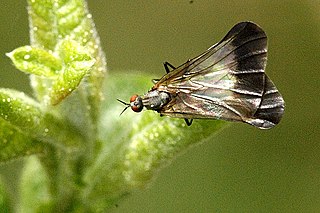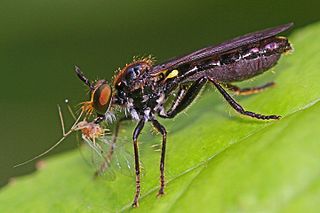
Empididae is a family of flies with over 3,000 described species occurring worldwide in all the biogeographic realms but the majority are found in the Holarctic. They are mainly predatory flies like most of their relatives in the Empidoidea, and exhibit a wide range of forms but are generally small to medium-sized, non-metallic and rather bristly.
Brevetoxin (PbTx), or brevetoxins, are a suite of cyclic polyether compounds produced naturally by a species of dinoflagellate known as Karenia brevis. Brevetoxins are neurotoxins that bind to voltage-gated sodium channels in nerve cells, leading to disruption of normal neurological processes and causing the illness clinically described as neurotoxic shellfish poisoning (NSP). Although brevetoxins are most well-studied in K. brevis, they are also found in other species of Karenia and at least one large fish kill has been traced to brevetoxins in Chattonella.

Karenia is a genus that consists of unicellular, photosynthetic, planktonic organisms found in marine environments. The genus currently consists of 12 described species. They are best known for their dense toxic algal blooms and red tides that cause considerable ecological and economical damage; some Karenia species cause severe animal mortality. One species, Karenia brevis, is known to cause respiratory distress and neurotoxic shellfish poisoning (NSP) in humans.

Rhamphomyia is a genus of dance flies, in the fly family Empididae. It contains more than 600 species in 8 subgenera.

Oscillatoria brevis is a species of the genus Oscillatoria first identified in 1892. It is a blue-green filamentous cyanobacterium, which can be found in brackish and fresh waterways. O. brevis can also be isolated from soil.
Rhamphomyia nasoni is a species of dance flies.

Eudioctria is a genus of robber flies in the family Asilidae. There are about 14 described species in Eudioctria.

Cicurina brevis is a species of araneomorph spider in the family Dictynidae. It is found in the USA and Canada. A study from 2024 found this species alive under seasonal snowpack in a region called the subnivium in higher concentrations than it was found in the summer time, indicating a potential seasonal specialization for the winter.
Ospriocerus brevis is a species of robber flies.
Pseudozonitis brevis is a species of blister beetle in the family Meloidae. It is found in North America.
Rhamphomyia sudigeronis is a species of dance flies.

Rhamphomyia longicauda, the long-tailed dance fly, is a species of fly commonly found in eastern North America that belongs to the family Empididae and part of the superfamily of dance flies Empidoidea. It is included in the subgenus Rhamphomyia. This species of fly is most known for sex role reversal during courtship, as females put on exaggerated displays and congregate in leks to attract males. Females cannot hunt for food, so they receive protein from nuptial gifts brought to them by males. Female dependence on males for nutrition is the principal cause for sex role reversal in this species of fly.
Eudioctria brevis is a species of robber flies in the family Asilidae.
Oodes brevis is a species of ground beetle in the family Carabidae. It is found in North America.
Rhamphomyia nana is a species of dance flies.
Rhamphomyia aucta is a species of dance flies, in the fly family Empididae. It is included in the subgenus Rhamphomyia.
Rhamphomyia cimrmani is a species of dance flies, in the fly family Empididae. It is included in the subgenus Lundstroemiella.
Rhamphomyia speighti is a species of dance flies, in the fly family Empididae. It is included in the subgenus Lundstroemiella.
Rhamphomyia strobli is a species of dance flies, in the fly family Empididae. It is included in the subgenus Lundstroemiella.






